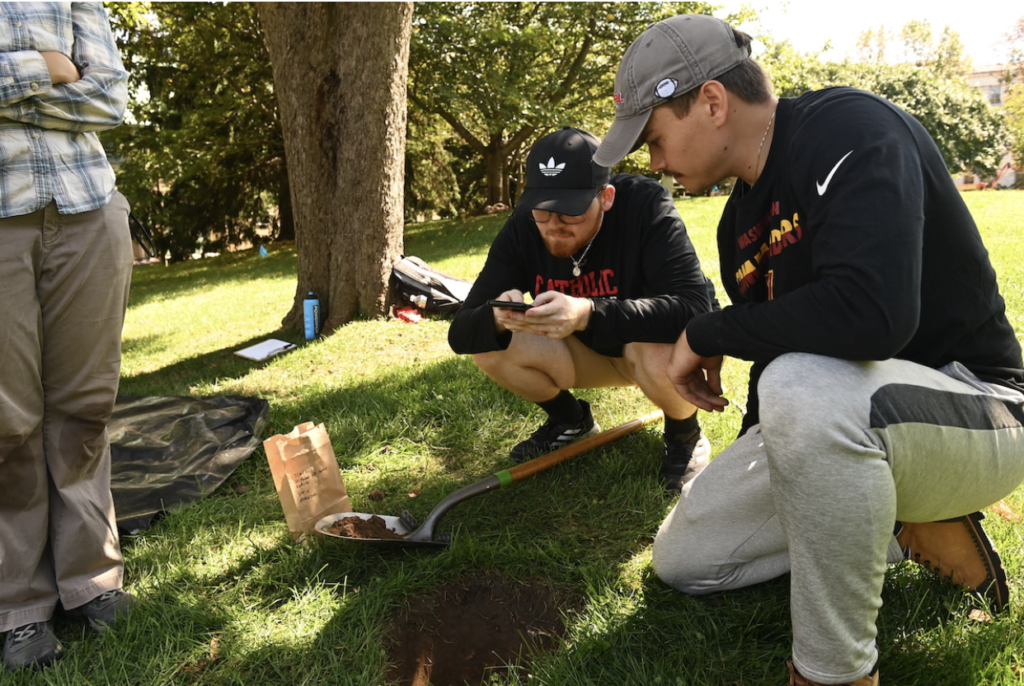Anthropology Students Discover the Past on Campus

Photo courtesy of Catholic Communications
By Jaci Jedrych
While walking around on campus for the past three weeks, you may have seen students digging on the hill outside the Pryz. These students, enrolled in Anthropology 351/551: Archaeological Field Methods, are discovering U.S. history through field work right here on Catholic University’s campus.
“While St. Thomas Hill is a beautiful grassy knoll today, it was actually the site of an early 19th-century rural estate, which ultimately played a role in early campus history as St. Thomas College/Hall,” explained Catholic University anthropology professor Dr. Laura Masur. “The site was partly surveyed by archaeologists, including Dr. David Clark, back in 1986. They recommended further survey of the area – so we’re returning to the site 36 years later to do that full survey.”
Seven students are currently enrolled in Archaeological Field Methods. They encourage visitors to check out their work on Fridays from 9:40 a.m. – 1 p.m. Their best find so far? “[F]ragments of a gramophone record, probably used by the students who lived at St. Thomas Hall in the 1910s and 1920s.”
Senior anthropology major Jane Pilato described the find.
“I found a piece of black plastic and got disheartened,” Pilato said. “Then I looked down and saw it was a fragment. I started digging more and pulled out another fragment. As I studied it, I realized that the grooves on it were too uniform.”
After calling Masur over, Pilato said that the professor confirmed the find. “She then dug in my pit and found some type of metal handle, most likely copper,” Pilato added. “It was pretty cool to imagine someone listening to this oh so long ago.”
For aspiring anthropologists, fieldwork is essential, but as it is often during the summer and unpaid, many students have difficulties participating. Catholic University’s program offers students a unique opportunity to gain these skills during the school year.
“Archaeology is fascinating – but it’s also a discipline that requires a lot of skills that you just can’t develop in the classroom,” Masur said. “Most often, students gain these skills during a ‘field school’—a 4-8 week summer training program in excavation techniques. A lot of our students at CUA work during the summer and cannot take a field school, so we in the anthropology department wanted to offer students an opportunity to develop these skills during the semester.”
Though one of the first on campus, the faculty has made many digs available to students in the past. The anthropology department works hard to make these opportunities commonly available to their students to ensure that they are properly prepared to be hired for entry-level positions.
“Anthropology is all about making connections, for example between data and interpretation, or between the past and present, or between different communities with diverse interests,” Clinical Associate Professor and Chair of the Anthropology department, Dr. Joshua Samuels said. “Projects like this showcase how we can build bridges to advance dialogue and enhance our understanding of each other and the world around us.”
In 2021 and 2022, half a dozen students and recent graduates joined professors at a site on the Eastern Shore of Maryland to do a survey similar to the one happening on St. Thomas Hill.
“I always welcome committed student volunteers on my field projects – I was in the field in Maryland for about a month this past summer.”
The project discovered artifacts that advanced research about the lives of enslaved people and collaborated with local communities to honor their ancestor’s voices. To learn more about the project, visit Still We Speak.
Though field skills are essential to the anthropological process, they are just the first step.
“It’s important to note that digging a site is only a fraction of what we do as archaeologists. For every day we spend in the field, it takes at least 5 days of lab processing and analysis to wash, sort, catalog, and analyze those artifacts, and prepare them for long-term curation. In the spring we’ll be offering a new archaeology lab class, where students will follow all of these steps with the collections from our dig at St. Thomas Hill.”
Volunteers of any major or experience level are welcome to come to learn in the lab this semester. Interested students should contact Dr. Masur at masur@cua.edu, or drop by Hannan 101.
“While we always associate archaeology with adventure and discovery in far-off places (and Indiana Jones), most American archaeologists work right here in the U.S., for private companies that work to comply with federal, state, and municipal preservation laws,” Masur said. “Archaeologists want to ensure that we preserve and study evidence of the past that is buried just out of sight – like the structure and artifacts that are buried right under St. Thomas Hill.”
“As archaeologist David Hurst Thomas famously said, ‘archaeology is not what you find, it’s what you find out.’ We are all excited when we discover something cool. But the real process of discovery is using those finds to tell us something new about the past… The students who are digging at St. Thomas Hill are not just digging – they are learning how to document and analyze all those cool finds, so we can learn more about our campus history.”






